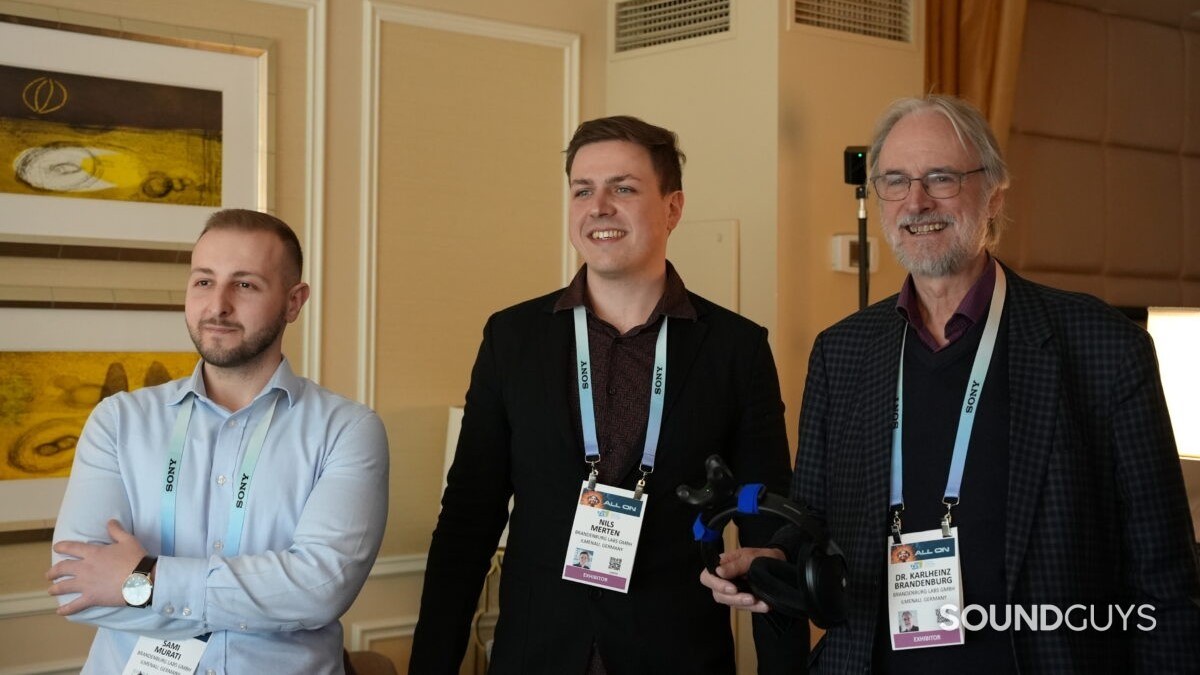All products featured are independently chosen by us. However, SoundGuys may receive a commission on orders placed through its retail links. See our ethics statement.
We tried Brandenburg Labs’ spatial audio, and here's why it's better

- Brandenburg Labs gave SoundGuys a demo of their immersive spatial audio experience at CES 2024, and we were impressed.
- Unlike current consumer spatial audio solutions, this system incorporates VR-like motion and head tracking to simulate moving in a listening environment.
- The Personalized Auditory Realities (PARty) concept is integral to the system, allowing for customizable auditory environments.
- The system currently relies on HTC Vive sensors for a 360-degree room scan but has the potential for future integration directly into a headset.
Brandenburg Labs, led by MP3 co-inventor Prof. Dr.-Ing. Karlheinz Brandenburg unveiled its latest Audio Augmented Reality Headphone System at CES 2024. Their proprietary software departs from traditional spatial audio solutions by integrating pre-recorded room data and VR-like head tracking to simulate a more immersive virtual listening experience.
True spatial audio?
Traditional spatial audio solutions try to make sounds feel like they’re coming from all around you, just like in real life. In fact, many headsets now feature head-tracking capabilities that pan your music based on your head position relative to the source device. Companies like Bose and Apple achieve this by including an Inertial Measurement Unit (IMU) in their headsets. This sensor typically contains a gyroscope and accelerometer. The data gathered from the IMU can then be used to calculate where your head is facing, allowing your headphones’ Digital Signal Processor (DSP) to adjust the sound accordingly. But it’s not perfect; sometimes, there’s a delay with the head tracking, or the adjustments from your headphones’ DSP may sound “off.”
However, Brandenburg Labs’ new system adds a new twist. They’ve created a system that understands where your head is and knows the specific layout of your room. It utilizes HTC Vive base station sensors that scan the room and keep tabs on your headset’s position and movement. This means the sound you hear is super precise, as it adjusts based on your location within the room.
We had the chance to test a comparison demo at CES 2024, where we compared the virtual sound of loudspeakers to real ones, and the difference between the two was nearly indistinguishable. When placing the headset on your head, the audio sounds just the same as it was coming out of the speakers. Aside from the physical sensation of the weight of the headphones, you would have no idea that the sound source has changed from the speakers to the headphones.
While this sounds awesome, there’s a bit of a catch. This advanced setup relies on external HTC Vive sensors and a scanned room model to work its magic. So, it’s not something you can just pop on your head and take anywhere like regular headphones. Changing surroundings, like walking outside, would throw off the accuracy. That said, future incorporation into VR/AR headsets could bring this technology into the home.
Though we’re not quite there yet for on-the-go use, this technology from Brandenburg Labs is a big step forward. It’s making sound more realistic and immersive, pushing the boundaries of what we thought headphones could do. As technology evolves, who knows? One day, you might be able to enjoy this super accurate spatial audio wherever you go. But for now, it’s an exciting development for audio professionals and future home entertainment settings.